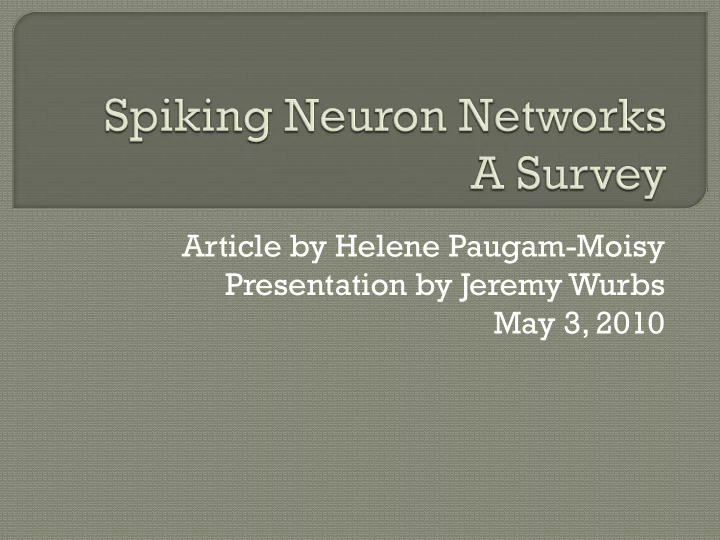

Article by Helene Paugam-Moisy Presentation by Jeremy Wurbs May 3, 2010
Motivation Biology SNN Models Temporal Coding ESN’s and LSM’s Computational Power of SNNs Training/Learning with SNNs Software/Hardware Implementation Applications Discussion
1 st Generation: • Perceptrons, Hopfield Networks, MLP with threshold units 2 nd Generation: • Networks with non-linear activation units and real-valued, continuous set of output units 3 rd Generation: • Spiking neuron networks, using firing times of neurons for information encoding
Four Ions: Na + Ca 2+ K + Cl - 3Na + -70 [mV] 2K + K + Na + K +
Alpha Function Integrator Coincidence Detector
Models membrane potential • Conductance-based • Defined in 1952 (Note: Na-K Pump disc. in 1957)
Considers spike as event Ions leak out, requiring time constant, τ
20 Possible Neuron Firing Behaviors LIF can only accommodate 3 (A,G, & L)
Two variables • Voltage Potential ( v ) • Membrane Recovery (activation of K currents and inactivation of Na currents) ( u ) • W is the weighted input(s), a, b, c & d are abstract parameters of the model When ( v > threshold), v and u are reset:
Adds a refractory period s s Weighted Sum External Current Spike & Spike Reset of Inputs
Hodgkin-Huxley • Accurate Modeling • Predicts membrane potentials due to pharmacological blocking of ion channels Integrate & Fire • Easy implementation • Computation-light Spike Response Model • Includes refractory phase
Rate Coding • Information transmitted by rates • I.E. number of spikes per unit time Temporal Coding • The exact timing of spikes matter
Reviewed models describe single neurons, still need to create networks Traditional Architectures • Use temporal coding to reduce SNN to NN • Refer to previous slide Echo State Networks & Liquid State Machines
Produce an echo state network Sample network training dynamics Compute output weights, use any linear regression algorithm SNs implemented in ESN outperform traditional ESNs
Turns time varying input into a spatiotemporal pattern of activation Large number of non-linear activation states Activations go into readout neuron(s) (linear discriminate units)
“A group of neurons with strong mutual excitatory connections.” Excite one, excite all (many) “Grandmother Neural Groups” Synfire chain: pool of in-sync neurons Transient synchrony • Leads to collective sync. event; computational building block, “many variables are cur. ~equal” Polychronization • "reproducible time-locked but not synchronous firing patterns"
Traditional Methods New SNN Methods
Hopfield Networks (Maass & Natschlager) Kohonen SOMs (Ruf & Schmitt) RBF Networks (Natschlager & Rug) ML RBF Networks (Bohte, La Poutre & Kok) SNN shown to be universal function approximaters
“When a pre-synaptic neuron repeatedly fires right before a post-synaptic neuron fires, the weight between the two neurons increases.” Hebbian Properties • Synaptic Scaling • Synaptic Redistribution • Spike-timing dependent synaptic plasticity
Maximization of mutual information BCM model Minimization of entropy • Minimize the response variability in the post- synaptic neuron given a particular input pattern
Event-driven Simulation • Vs. time-driven simulation • Most of the time neurons aren’t firing, so • Calculate when firing events occur, not what every neuron is doing at every time step • Delayed firing problem Parallel • SpikeNET • DAMNED simulator
Hopfield and Brody, Digit Recognition • Generalize from small number of examples • Robust to noise • Uses temporal integration of transient synchrony • Time warp invariant • A set of neurons fire synchronously to a particular input (transient synchrony) Many examples in • Speech processing • Computer Vision
Spiking Neuron Networks • Biologically motivated • Computationally difficult without simplification • Traditional learning rules don’t take advantage of timing sequencing • New learning rules will have to be forthcoming before SNN show their potential
Recommend
More recommend